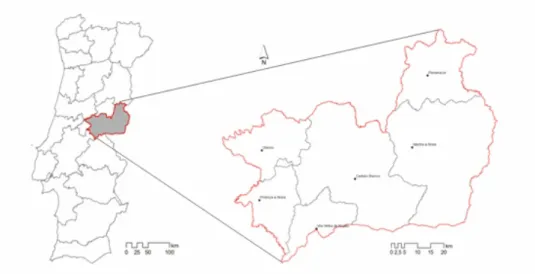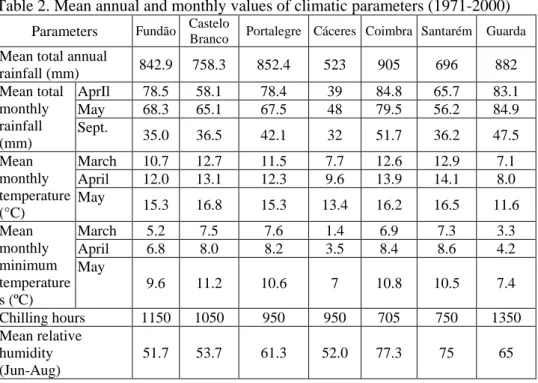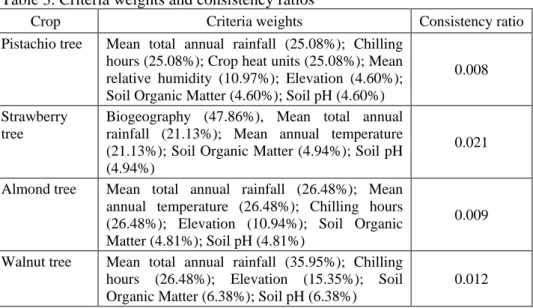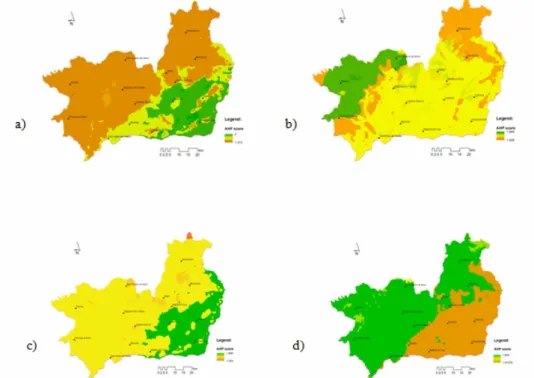Quinta-Nova, L., Ferreira, D. (2020): Land suitability analysis for emerging fruit crops in Central Portugal using GIS. Agriculture and Forestry, 66 (1): 41-48.
DOI: 10.17707/AgricultForest.66.1.05
Luís QUINTA-NOVA 1*, Dora FERREIRA2
LAND SUITABILITY ANALYSIS FOR EMERGING FRUIT CROPS IN CENTRAL PORTUGAL USING GIS
SUMMARY
Fruit production is an important component of agricultural production in Portugal, and it has a positive impact on the economy, especially in rural areas. In recent years, there has been increased investment in so-called ‘emerging crops’. It is agreed that using the crops that are best suited to the soil and climate conditions as well as the socio-economic environment promotes sustainable use in rural areas. The objective of this study is to determine the suitability of different emerging fruit crops for cultivation in the Beira Baixa region based on analysis of soil and climate factors. The pistachio tree (Pistacia vera L.), strawberry tree (Arbutus unedo L.), almond tree (Prunus dulcis (Mill.) DA Webb) and walnut tree (Juglans regia L.) were checked against the biophysical criteria for cultivation. The results were processed using a geographic information system. Analysis was performed using the analytical hierarchy process (AHP). Thus, after dividing the problem into hierarchical levels of decision-making, a pairwise comparison of criteria was performed to evaluate the weights of these criteria based on a scale of importance. Then, the consistency of these operations was validated. The AHP was adequate for evaluation of fruit tree species’ suitability since it enabled integration of several criteria, decision-making and problem resolution. It is essential to be aware of the suitability and resilience of new crops in order to meet the need to adapt to climate change.
Keywords: Multi-criteria evaluation, Land use suitability, Fruit cultivation, Analytic Hierarchy Process, GIS.
INTRODUCTION
The current trends indicate that are emerging a new consumers profile that are looking for an increased of variety, freshness and healthy options and they are also seeking a higher proportion of fresh and different produce in their eating choices (Campos & Madureira, 2019).
1
Luís Quinta-Nova (corresponding author: lnova@ipcb.pt), Polytechnic Institute of Castelo Branco, Portugal; CERNAS - Research Centre for Natural Resources, Environment and Society, Castelo Branco, Portugal;
2
Dora Ferreira, Polytechnic Institute of Castelo Branco, PORTUGAL; University of Extremadura, SPAIN.
Paper presented at the 10th International Scientific Agricultural Symposium "AGROSYM 2019". Notes: The authors declare that they have no conflicts of interest. Authorship Form signed online.
Received:25/10/2019 Accepted:22/12/2019
The concept of sustainability agriculture indicate that is necessary to promote the accountable use of resources, such water and nutrients, and decreasing the use of pesticides in a way which considers the future needs and will not compromise the quality of the environment. Which indicates that is important to respect the agro climatic conditions and identify and promote the appropriate adaptation strategies of the crops.
The Beira Interior region of Portugal is characterized by soil and climate conditions favorable to peach and cherry production (Simões et al., 2015), representing the crops with more public investment and expansion (Lopes, Alberto, Luz, & Simões, 2018). It is the most productive region of these fruits in Portugal, containing 1640 ha of peach crops and 2230 ha of cherry crops (INE, 2014 in Ferreira et al., 2016), which represents 45% of the national area of peach production and 39% of the cherry production area. However, in the last five years that region is seeking new patterns and configuration of agrarian landscape, introducing the new fruit crops, through the foreign investments and benefiting from new irrigation infrastructures. The emerging crops that are identified in the aim of this study are the almond tree, pistachio tree, strawberry tree and walnut tree, distributed by different areas across the Beira Interior region.
Facing the trends of climate change is urgent to address agricultural adaptation more coherently and promote the suitability of plant, weather and soil conditions. Hence, that investigation identifies the suitable sites for the emergent crops production using a model based on multi-criteria spatial analysis AHP. The suitable areas for the emerging crops are determined by an evaluation of the climate, soil and topographical factor and the understanding of local biophysical restraints. In this kind of situation, many variables are involved and each one should be weighted according to their relative importance on the optimal growth conditions for crops through multicriteria evaluation and Geographic Information Systems.
Multicriteria spatial decision analysis has been widely applied in various studies in different fields, many of which are published and have been cited by many authors as processes of relevant decision making. This is the case of Kangas, et al. (2000) referring to the use of GIS in the decision-making process through the multicriteria analysis in the planning of forest resources conservation actions, allowing actions as directed by the determination of the priority areas. Quinta-Nova & Roque (2014) developed a model based on multicriteria spatial analysis AHP to determine the suitability levels for agroforestry uses of the sub region of Beira Interior Sul. The criteria used were the soil potential, slope and aspect. The authors note that this analysis identified the areas where the use of land should be subject to a conversion and/or a change of management.
This work was intended to identify the suitable areas which can be exploited for the fruit production with new crops in the Beira Baixa region, by the integration of several criteria. In this research, site suitability analysis was carried out using GIS and AHP as multicriteria decision analysis (MCDA) technique. It
is therefore essential to be aware of the suitability and resilience of new crops in order to meet the need to adapt to climate change.
MATERIAL AND METHODS
The Beira Baixa region is an administrative division in eastern Portugal and integrates the Beira Interior Region. The region covers an area of 4,614.6 km² and has a population of 84,046 inhabitants. The area includes four municipalities: Idanha-a-Nova, Penamacor, Vila Velha de Ródão and Castelo Branco. This territory is mainly occupied by forest and agroforestry uses (60.8 %) and agriculture (36.2 %).
Figure 1. Study area location
The classification of the crops suitability resulted from the integration of a set of biophysical criteria based on the climate and soil requirements of crops and the optimal operating conditions associated with different uses. Geoprocessing and spatial analysis was performed to geographic data, namely soils, climate and elevation. In this study all the criteria (Table 1) are reflected in the corresponding GIS layers.
To characterizing the main climatic parameters that influence the crops studied in different stages and therefore its productive potential, are used the climate data of 7 meteorological stations around Beira Baixa region (Fundão, Castelo Branco, Portalegre, Coimbra, Guarda, Santarém in Portugal, and Caceres in Spain). In Table 2 are identified the stations nearest of the region and identified the main representative climatic parameters that are influence to crops ecological conditions. Was observed that the mean of total annual rainfall goes by 523 mm (Cáceres) until 882 mm (Guarda). During the blossom period the rain can damage fruit production, specially combining with low temperatures (with risk of frost). The mean monthly minimum temperatures registered during the blossom period
was around 3.5ºC and 6,8ºC and 11,2ºC of minimum in Castelo Branco.
Generally, the mean relative humidity during the fruits growth with
average
of 62%, that parameter is important because influence the diseases risks of the crops and influence their capacity of evapotranspiration.Table 1. Criteria considered in determining crop suitability
Table 2. Mean annual and monthly values of climatic parameters (1971-2000) Parameters Fundão Castelo
Branco Portalegre Cáceres Coimbra Santarém Guarda
Mean total annual
rainfall (mm) 842.9 758.3 852.4 523 905 696 882 Mean total monthly rainfall (mm) AprIl 78.5 58.1 78.4 39 84.8 65.7 83.1 May 68.3 65.1 67.5 48 79.5 56.2 84.9 Sept. 35.0 36.5 42.1 32 51.7 36.2 47.5 Mean monthly temperature (°C) March 10.7 12.7 11.5 7.7 12.6 12.9 7.1 April 12.0 13.1 12.3 9.6 13.9 14.1 8.0 May 15.3 16.8 15.3 13.4 16.2 16.5 11.6 Mean monthly minimum temperature s (ºC) March 5.2 7.5 7.6 1.4 6.9 7.3 3.3 April 6.8 8.0 8.2 3.5 8.4 8.6 4.2 May 9.6 11.2 10.6 7 10.8 10.5 7.4 Chilling hours 1150 1050 950 950 705 750 1350 Mean relative humidity (Jun-Aug) 51.7 53.7 61.3 52.0 77.3 75 65 Criteria Description Mean annual temperature
Average of the 12 mean monthly temperatures (ºC) Mean total annual
rainfall
Total annual depth of precipitation from a given precipitation time series (mm)
Chilling hours Sum of hours with temperature ≤ 7.2 °C (h) Crop heat units Influence of temperature on a crop’s growth and
development (h) Mean relative humidity
Ratio of the actual amount of water vapour present in a volume of air at a given temperature to the maximum amount that the air could hold at that temperature (%) Biogeography Portugal biogeographic units and adapted species
Elevation Height above the Earth's sea level (m) Soil pH Measure of the acidity or alkalinity of a soil Soil Organic Matter Fraction of the soil that consists of plant or animal tissue
The different layers corresponding to each criteria were classified in two suitability levels: low or medium suitability (1) and high suitability (2). After creating layers resulting from the reclassification in suitability levels, the general suitability for each crop was performed using a multicriteria decision analysis - the Analytic Hierarchy Process - AHP (Saaty, 1980).
The AHP decomposes a problem, question or decision, in all the variables that constitute it, in a scheme of criteria and subcriteria and then makes pairwise comparisons between them (Antunes, 2012). The comparison between criteria is made using a scale of 1 to 9, wherein 1 is equally preferred and 9 is highly preferred (Saaty, 1980). The AHP reverts comparisons on numerical values that can be processed and compared to the full extent of the problem. The AHP calculates the weight value for each criterion (wi) by taking the eigenvector corresponding to the largest eigenvalue of the matrix, and then normalizing the sum of the components to a unity. Pairwise comparison matrices were used with AHP software in order to value the selected factors and their classes.
The consistency of the matrix after obtaining the weight values is judged based on a consistency ratio CR. If CR < 0.10, the pairwise comparison matrix is considered to have acceptable consistency and the weight values calculated are considered valid and can be utilized. Finally the spatial data was superimposed to integrate all the factors in a single layer - the suitability map for each crop.
RESULTS AND DISCUSSION
The AHP analysis of the selected crops indicates that the climatic influence is determinant in the development of these species, since its weight in the AHP analysis varies between 62.43% for Walnut tree and 90.12% for Strawberry tree. Table 3. Criteria weights and consistency ratios
Crop Criteria weights Consistency ratio
Pistachio tree Mean total annual rainfall (25.08%); Chilling hours (25.08%); Crop heat units (25.08%); Mean relative humidity (10.97%); Elevation (4.60%); Soil Organic Matter (4.60%); Soil pH (4.60%)
0.008
Strawberry tree
Biogeography (47.86%), Mean total annual rainfall (21.13%); Mean annual temperature (21.13%); Soil Organic Matter (4.94%); Soil pH (4.94%)
0.021
Almond tree Mean total annual rainfall (26.48%); Mean annual temperature (26.48%); Chilling hours (26.48%); Elevation (10.94%); Soil Organic Matter (4.81%); Soil pH (4.81%)
0.009
Walnut tree Mean total annual rainfall (35.95%); Chilling hours (26.48%); Elevation (15.35%); Soil Organic Matter (6.38%); Soil pH (6.38%)
The analysis of the consistency ratio (CR) of the AHP showed that there was consistency in the pairwise comparison matrix, and thus, the weight values calculated could be considered valid (Table 3).
Based on the map analysis, about 75,235 hectares, corresponding to 16.4% of the total area available, are classified as highly suitable for almond tree, especially in the south east part of the region. Low winter and spring temperatures and very high summer temperatures inhibit growth and fruit set. On the other hand, very high summer temperatures when accompanied with low soil moisture can result in the shrinkage of almond. The needs of almond in cold (in order to break the dormancy of the buds) are 250-350 (and in some cases over 500) hours of exposure to temperature less than 7 °C (Alonso, et al. 2005).
Figure 2. Crop suitability maps: a) Almond tree - Prunus dulcis; b) Strawberry tree - Arbutus unedo; c) Pistachio tree - Pistacia vera; d) Walnut tree - Juglans regia
Strawberry tree is one of the most common fleshy fruited species in the Mediterranean region. The area with high suitability to strawberry tree is 72,423 hectares, corresponding to 15.8% of the total area available, corresponding to northwest of the region, in an area with higher altitude (around 600-800 m) with more suitable climatic conditions and topographic adaptation.
The area with higher potential to pistachio tree is 72,679 hectares, corresponding to 15.9% of the total area available and overlaps the potential almond tree crop area, resulting from natural conditions, especially the climatic
influence. This plants are known as drought tolerant and are able to survive and even produce fairly yield with very little water (Ferguson et al., 2002). An annual rainfall of at least 300 to 450 mm has been reported as the optimum amount of precipitation for this crop (Goldhamer, 2005).
In the case of walnut tree, highlighting the total 288,983 hectares, corresponding to 63.2% of the total area available. Higher precipitation (minimum of 600 mm) during the winter and the temperature are the main parameters that compromise this crop, especially in the last case, during the opening of male flowers.
In Figure 2 we present the crop suitability maps resulting from the Analytical Hierarchy Process.
CONCLUSIONS
This methodological approach allowed us to assess the suitability of four emerging fruit crops (Almond tree Strawberry tree, Pistachio tree and Walnut tree) in the Beira Baixa region of Portugal. The AHP was based on a set of criteria contributing to a reflection on the adequacy of those crops for the climatic and soil characteristics of the region. The crops suitability maps thus obtained enable decision making. The main results obtained indicate that the methodology used, using AHP and GIS, could provide a guide map for decision makers in order to achieve better agriculture productions facing their ecological limitations. The results put on evidence the biophysical evaluation of territory and provide information at a local level that could be used by farmers to choose their crops.
For further study is recommend to select other factors, like irrigation facilities and socio-economic factors, and other parameters which influence the sustainable land use. However, further investigation is needed to integrate the impact of climate change in crops planning to assist in supporting future national strategies for agriculture.
ACKNOWLEDGEMENTS
This work is supported with Portuguese national funds by FCT - Foundation for Science and Technology, I.P., within the GEOBIOTE - UID/GEO/04035/2019.
REFERENCES
Alonso, J., Ansón, J., Espiau, M. and Socias i Company, R. (2005). Determination of endormancy break in almond flower buds by a correlation model using the average temperature of different day intervals and its application to the estimation of chill and heat requirements and blooming date. Journal of American Horticultural Science, 130, 308-318.
Antunes, O.E.D. (2012). Multicriteria GIS analysis for determination of a spacialized index of coastal anthropogenic pressure. Cases of Espinho, Caparica and Faro. Dissertação de Mestrado em Gestão do Território. Área de Especialização em Deteção Remota e Sistemas de Informação Geográfica. Universidade Nova de Lisboa. Faculdade de Ciências Sociais e Humanas. Lisboa.
Campos, S., & Madureira, L. (2019). Can Healthier Food Demand be Linked to Farming Systems’ Sustainability? The Case of the Mediterranean Diet. International Jornal of Food System Dynamics, 10(3), 262–277. https://doi.org/10.18461/ijfsd.v10i2.17 Ferguson, L., Poss, J., Grattan, S., Grieve, C., Wang, D., Wilson, C., Donovan, T., Chao, C.-T. (2002). Pistachio rootstocks influence scion growth and ion relations under salinity and boron stress. Journal of the American Society for Horticultural Science. 127: 194-199
Ferreira, D., Simões, M.P., Martins, C., & Gaspar, P.D. (2016). Triple Helix in Agriculture Context: The case of Prunus Network in Beira Interior Region. In Regional HELIX Conference 2016 - International Conference on Regional Triple Helix Dynamics (pp. 1-10).
Goldhamer, D.A. (2005). Tree water requirements and regulated deficit irrigation. Pistachio Production Manual. 103-116
Kangas, J., Store, R.L., Leskinen, P., Mehtatalo, L. (2000). Improving the Quality of Land-scape Ecological Forest Planning by Utilizing Advanced Decision-Support Tools. Forest Ecology and Management, Amsterdam, v.132, p.157-171.
Lopes, C., Alberto, D., Luz, J. P., & Simões, M. P. (2018). As Políticas Agrícolas Aplicadas à Fruticultura em Produção Integrada na Beira Interior : O Estudo de Caso do Setor das Prunóideas na Cova da Beira. (Agricultural Policies Applied to Integrated Fruit Production in Beira Interior: The Case Study of The Stone Fruits Sector in Cova da Beira) Revista Portuguesa de Estudos Regionais, 49, 98–101. Quinta-Nova, L.C., Roque, N. (2014) Agroflorestal Suitability Evaluation of a
Subregional Area in Portugal Using Multicritéria Spacial Analysis. Internacional Congress of Landscape Ecology - Understanding Mediterranean Landscapes Human vs. Nature, 23-25 October. Antalaya. Turkey.
Simões, M.P., Alberto, D., Dias, C., Duarte, A.C., Ferreira, D., Gavinhos, C., Castanheira, I. (2015). O projeto + pêssego - inovação e desenvolvimento na cultura do pessegueiro na região da beira ("+Peach" Project: Innovation and development of peach production in Beira Interior Region of Portugal). In III Jornadas Potencial Técnico e Científico do IPCB (pp. 25-27).



